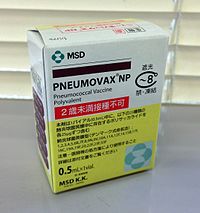
Photo from wikipedia
BackgroundTo summarize information about invasive pneumococcal disease (IPD) among children in mainland China.MethodsSixteen eligible studies were included in this systematic review and the random effect model was used to estimate… Click to show full abstract
BackgroundTo summarize information about invasive pneumococcal disease (IPD) among children in mainland China.MethodsSixteen eligible studies were included in this systematic review and the random effect model was used to estimate the pool prevalence of IPD.ResultsThe most predominant serotypes circulating in children were 19F (27.7, 95% confidence interval (95% CI): 17.7–37.6%), 19A (21.2%, 16.4–26.1%), 14 (16.5%, 12.8–20.1%), 6B (8.6%, 5.2–10.8%) and 23F (7.3%, 5.2–9.5%). The serotype coverage of the available pneumococcal conjugate vaccines PCV7, PCV10, and PCV13 was 60.8% (52.5–69.4%), 65.1% (57.7–72.4%), and 90.0% (87.1–92.8%), respectively. The pooled antibiotic resistance rates of Streptococcus pneumoniae revealed a resistance to penicillin prevalence rate of 32.0% (12.1–51.9%). Approximately 94.4% (90.7–98.1%) and 92.3% (87.4–97.3%) of isolates were resistant to erythromycin and clindamycin. eBURST analysis revealed great diversity among isolates, with 102 sequence types (STs) for 365 isolates. The major predominant clonal complexes (CCs) were CC271 (43.6%, 159/365), CC876 (13.4%, 49/365), CC81 (5.2%, 19/365), and CC90 (4.1%, 15/365). Long-term and regional surveillance of S. pneumoniae is necessary.ConclusionsBased on our pooled results showing that PCV13 coverage of the reported serotypes was 90% and that most serotypes contributed to the distribution of antibiotic-resistant isolates, implementation of PCV13 into the Chinese Expanded Program on Immunizations (EPI) would achieve health benefits in Chinese children.
Journal Title: BMC Pediatrics
Year Published: 2019
Link to full text (if available)
Share on Social Media: Sign Up to like & get
recommendations!